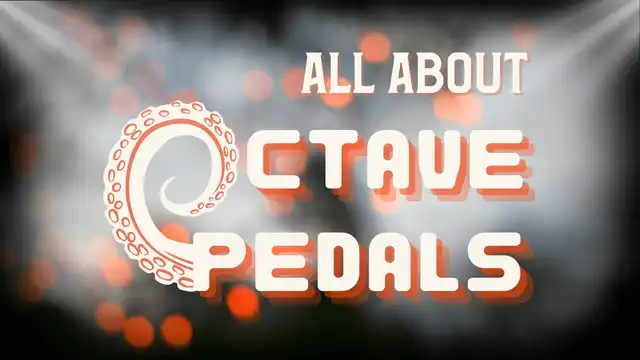All About Octave Pedals


Often overlooked in discourse on magic numbers, eight is pretty great - particularly if you like: 1) cephalopods, 2) bytes, 3) furlongs, 4) the interval between two musical notes where one note has a frequency that is double that of the other. If that last one resonates, you might be interested in celebrating a piece of gear that has enchanted players for decades: the octave pedal. This humble yet powerful effect has become a staple in guitar rigs across the world, offering players the ability to manipulate pitch, add depth, and create hauntingly beautiful sounds. Let's dive into the origins, technology, famous models, and iconic players associated with the musical marvel that is the octave pedal.

Octave Origins
The history of the octave pedal can be traced back to the late 1960s, when guitarists were pushing the boundaries of sound with distortion, fuzz, and various effects. In this era of innovation, the first octave pedals emerged, offering something previously unheard of: the ability to shift the pitch of a guitar's signal by one or more octaves.
One of the earliest octave pedals, and perhaps the most iconic, was the Octavia. Developed by Roger Mayer, a renowned engineer and effects designer, the Octavia made its debut in 1967. Mayer had been working closely with none other than Jimi Hendrix, and the Octavia became a key element in the guitarist's legendary tone. The Octavia combined a fuzz effect with an octave-up signal, creating a screaming, otherworldly sound that can be heard on tracks like "Purple Haze" and "Fire." This pedal wasn’t just a tool—it was an extension of Hendrix’s creativity, allowing him to transcend the limitations of traditional guitar tones.
The concept of the octave pedal expanded in the following decades, as technology evolved and more companies entered the effects market. Soon, players were able to choose from a variety of octave options, with pedals that could produce both higher and lower octaves, opening up an entirely new sonic palette.
Octave Tech
At its core, an octave pedal works by duplicating the original signal from the guitar and shifting the pitch up or down by one or more octaves. The technology behind octave pedals relies on pitch-shifting algorithms or analog circuitry, depending on the type of pedal. Early octave pedals like the Octavia used analog circuits to achieve the effect, while modern digital octave pedals employ complex algorithms for precise pitch-shifting.
Analog Octave Pedals
Analog octave pedals use simple components like diodes, transistors, and transformers to manipulate the signal. These pedals tend to have a raw, organic sound, often adding subtle imperfections that can create a more "human" feel to the effect. Analog octave pedals typically produce octave-up effects, as achieving a clean and stable lower octave was more challenging with analog technology.
In analog pedals, the guitar signal is typically distorted in some way, and then that distorted signal is "multiplied" in frequency to create the octave effect. The result is an aggressive, harmonically rich sound that cuts through a mix with ease. These analog octave pedals are especially popular among players who favor vintage-style fuzz tones and gritty textures.
Digital Octave Pedals
With the rise of digital technology, octave pedals became more versatile. Digital octave pedals use sophisticated pitch-shifting algorithms to create both higher and lower octaves with greater accuracy and stability. These pedals often allow players to blend in multiple octaves simultaneously, resulting in a thicker, fuller sound. Additionally, digital pedals can track pitch more accurately, making them better suited for polyphonic playing (chords) compared to their analog counterparts, which often struggle with tracking more than one note at a time.
Digital octave pedals also allow for more customization, with features like octave range selection, dry/wet blend controls, and even MIDI compatibility in some high-end models.
Legendary Octave Pedals
Over the years, numerous octave pedals have left their mark, from classic fuzz/octave combinations to modern, feature-packed digital units. Let's explore some of the most famous and beloved octave pedals.
1. Roger Mayer Octavia
The Roger Mayer Octavia is the grandfather of all octave pedals, known for its iconic fuzz/octave-up effect. As mentioned earlier, this pedal was heavily associated with Jimi Hendrix, who used it to create some of the most recognizable guitar tones in rock history. The Octavia’s combination of a searing fuzz and an upper octave effect gave Hendrix the ability to make his guitar scream in ways that had never been heard before. Its influence on rock, blues, and psychedelic music cannot be overstated.
2. Electro-Harmonix POG (Polyphonic Octave Generator)
The Electro-Harmonix POG is one of the most versatile and popular digital octave pedals ever created. Unlike the analog octave pedals of the past, the POG is fully polyphonic, meaning it can handle complex chords without glitching or losing clarity. The POG allows players to generate both sub-octaves (lower than the original pitch) and octave-up effects, with precise control over the blend of each. This pedal is known for creating lush, organ-like tones, which have found their way into a variety of musical genres, from indie rock to ambient music.
3. Boss OC-2 (Octave)
The Boss OC-2, released in 1982, is one of the most famous analog octave pedals in history. It was one of the first pedals to provide a lower octave effect, offering guitarists the ability to thicken their sound by adding up to two octaves below the original signal. The OC-2’s signature warm, fat sound became a favorite among bassists as well, who could use the pedal to make their instrument sound even deeper and more powerful. Although it has been succeeded by the OC-3, the OC-2 remains a sought-after pedal for players looking for that vintage octave tone.
4. MXR Blue Box
The MXR Blue Box is a unique take on the octave pedal. Instead of focusing on clean pitch-shifting, the Blue Box is a fuzz pedal with a built-in octave-down effect. It generates a heavily distorted sound that is doubled an octave lower, resulting in a thick, gnarly tone that is both chaotic and musical. Jimmy Page famously used the Blue Box on Led Zeppelin’s "Fool in the Rain," where its glitchy, unpredictable sound added to the song's distinct vibe.
Notable Octave Pedalers
The octave pedal has become a key part of many iconic guitarists' rigs. Whether used to create experimental sounds or to add depth to a solo, the octave pedal has found a home in a wide range of musical genres. Here are some of the most notable players who have used octave pedals to great effect.
1. Jimi Hendrix
As the pioneer of the octave pedal, Jimi Hendrix used the Roger Mayer Octavia to craft some of the most mind-bending guitar solos of his career. Tracks like "Purple Haze" and "Fire" showcase his mastery of the effect, blending the octave-up sound with his signature fuzz tone to create a sound that was both aggressive and ethereal.
2. Tom Morello
Tom Morello of Rage Against the Machine is known for his innovative use of effects, including the Digitech Whammy, a pedal that allows him to shift pitch by octaves at the press of a footswitch. Morello’s solos, like the one in "Killing in the Name," often use octave-shifting to create otherworldly sounds that are as much a part of his signature style as his riffs and rhythm playing.

3. Jack White
Jack White, both in his work with The White Stripes and as a solo artist, has often used octave pedals to create his unique, raw sound. The Electro-Harmonix POG is a key part of his pedalboard, allowing him to fatten up his guitar tone and create massive, organ-like sounds. White’s love of simplicity and raw power has made octave pedals a natural fit in his music.
Octaves Are for Everybody
The octave pedal is a powerful tool that has left an indelible mark on music history. From its early days in Hendrix’s rig to its modern incarnations in the hands of innovative modern guitar heroes like Tom Morello and Jack White, the octave pedal continues to inspire guitarists to push the boundaries of their sound. Whether you're looking to add depth to your playing, create otherworldly textures, or simply explore new sonic possibilities, an octave pedal is a must-have addition to any guitarist's rig. With a trusty guitar and a fresh set of Stringjoys, we know you'll find at least eight things you love about the way they make you sound.
Other Posts you may like

Guitar Strings Order: How the Guitar is Tuned and Why

Two Handed Tapping: Our Top 8 Tappers of All Time

Which Guitar Strings Wear Your Fret Wire Down More?

What is Nashville Tuning? Its History, Best Guitar Strings & Uses

Guitar Scale Length Explained: String Tension & Playability

What Guitar Strings I Used To Play...
0 Responses
Leave a Reply
Your email address will not be published. Required fields are marked *

